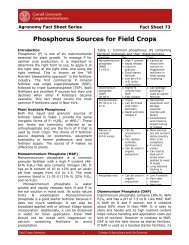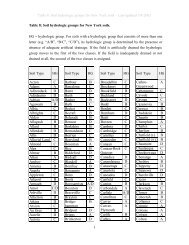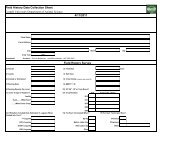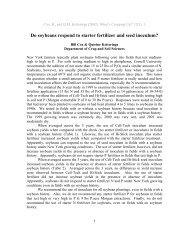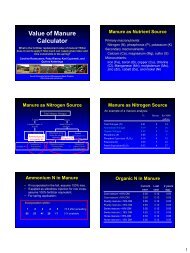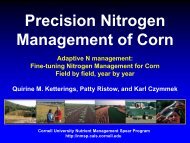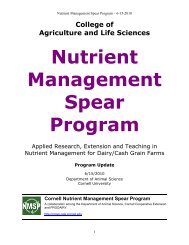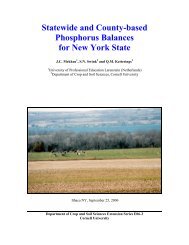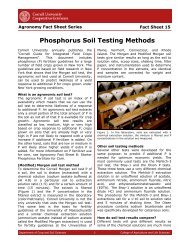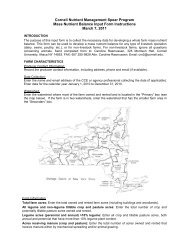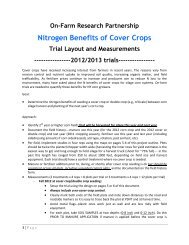Chie Miyamoto - Cornell University Nutrient Management Spear ...
Chie Miyamoto - Cornell University Nutrient Management Spear ...
Chie Miyamoto - Cornell University Nutrient Management Spear ...
You also want an ePaper? Increase the reach of your titles
YUMPU automatically turns print PDFs into web optimized ePapers that Google loves.
Students and Extension<br />
<strong>Chie</strong> <strong>Miyamoto</strong> #6<br />
Japanese Cobleskill Student Interns at <strong>Cornell</strong><br />
By Kate Birchenough<br />
<strong>Chie</strong> <strong>Miyamoto</strong>, a recent SUNY Cobleskill<br />
graduate, spent the last 15 weeks working with<br />
<strong>Cornell</strong> <strong>University</strong>’s <strong>Nutrient</strong> <strong>Management</strong><br />
<strong>Spear</strong> Program (NMSP), for her bachelor’s<br />
internship. She came to Cobleskill from Japan<br />
without any prior knowledge of agriculture, but<br />
expressed great interest in environmental<br />
science and related issues, thus leading her<br />
down the plant science path at the college.<br />
In order to complete her bachelor’s at SUNY<br />
Cobleskill, she began looking for an internship<br />
that satisfied both her academic and personal<br />
interest in the environment. Her main advisor<br />
at Cobleskill, Plant Science Professor and<br />
Department Chair Dr. John Kowal, directed her<br />
toward the <strong>Spear</strong> Program at <strong>Cornell</strong><br />
<strong>University</strong>, after seeing the internship<br />
presentation of Wayne Berry, another Cobleskill<br />
graduate and former NMSP intern.<br />
Cobleskill-<strong>Cornell</strong> intern <strong>Chie</strong> <strong>Miyamoto</strong> helps harvest<br />
alfalfa in a greenhouse sulfur application experiment.<br />
“<strong>Chie</strong> was very focused and knew what she<br />
wanted before she knew about Dr. Ketterings’<br />
work,” said Kowal. “After I saw Wayne’s<br />
presentation, it all clicked.”<br />
“I knew I was interested in soil science and<br />
laboratory work,” she said. “So I asked Dr.<br />
Kowal and that is when I checked the NMSP<br />
website. What I saw on the site was very<br />
interesting, and when offered the opportunity<br />
to join the program as an intern, I decided to<br />
take it.”<br />
The college <strong>Miyamoto</strong> attended in Japan has<br />
a relationship with SUNY Cobleskill, so<br />
<strong>Miyamoto</strong> decided to make the most of her<br />
college years and study in the United States.<br />
“I studied environmental science and<br />
related issues for my associate’s degree,” she<br />
said. “It was then that I had to take a soil<br />
science class – I found it really interesting; I<br />
got really into it.”<br />
She worked directly with Dr. Quirine<br />
Ketterings, of NMSP, and <strong>Cornell</strong> <strong>Nutrient</strong><br />
Analysis Laboratory (CNAL) Director Dr. Renuka<br />
Rao on two major projects: the Illinois Soil<br />
Nitrogen Test (ISNT) project and alfalfa-sulfur<br />
project.<br />
<strong>Miyamoto</strong> learned to conduct the ISNT in<br />
the laboratory, a soil test that was being<br />
studied for its potential to help farmers and<br />
consultants assess the soil nitrogen supply<br />
potential of fields to aid with nitrogen fertilizer<br />
decisions on farms. She developed the<br />
documentation for ISNT standard operating<br />
procedures for the test and it can now be<br />
offered as a CNAL service to growers in New<br />
York State.<br />
Ketterings, forage specialists Debbie and<br />
Jerry Cherney, and Kevin Dietzel, a staff<br />
member at NMSP, had discussed the need for a<br />
sulfur soil test as part of their study on sulfur<br />
needs for alfalfa. The main research question<br />
was which soil test is the best index of sulfur<br />
availability for alfalfa and possibly other field<br />
crops. For this project <strong>Miyamoto</strong> searched<br />
through literature and developed both a<br />
literature summary and a research protocol and<br />
implemented the research. She selected two<br />
soils from the larger sulfur study, incubated<br />
them with different amounts of sulfur, and then<br />
once the incubation was complete, she worked<br />
with Rao and the CNAL staff to conduct five<br />
different soil sulfur tests to see which soil test<br />
Department of Animal Science 1 College of Agriculture and Life Sciences
extraction and detection methods were most<br />
promising. During her internship she also<br />
participated in a greenhouse study on sulfur<br />
needs for alfalfa, and helped with research<br />
station and on-farm field trials.<br />
Though <strong>Miyamoto</strong> admits not having much<br />
of an agricultural background, what she learned<br />
in the classes she took, including soil fertility,<br />
plant nutrition and plant science courses,<br />
helped her understand the reasoning behind<br />
the research she was doing at <strong>Cornell</strong>.<br />
“I was amazed at <strong>Chie</strong>’s positive attitude<br />
and work ethic, even for tasks that were new to<br />
her and topics that she was asked to develop<br />
first approaches or drafts for on her own”, said<br />
Dietzel, who worked closely with <strong>Miyamoto</strong> on<br />
the sulfur project.<br />
Also Ketterings noted <strong>Miyamoto</strong>’s innate<br />
ability to work independently as well as a<br />
member of the larger team.<br />
“She started out with helping other students<br />
and staff in their projects but it did not take<br />
long for me to realize she was more than ready<br />
to undertake an independent research project<br />
of her own. She had a solid background in plant<br />
science and soil science and quickly picked up<br />
on the applications of both to nutrient<br />
management questions,” said Ketterings. “It<br />
has been really great to see her take on this<br />
project, develop the protocols and gain skills in<br />
the analytical procedures.”<br />
“<strong>Chie</strong>’s work contributes greatly to the<br />
extension and research missions of the <strong>Cornell</strong><br />
<strong>Nutrient</strong> Analysis Laboratory,” said Rao. “The<br />
joint project between CNAL and the <strong>Nutrient</strong><br />
<strong>Management</strong> <strong>Spear</strong> Program gave us a chance<br />
to address a long-standing research and<br />
extension question and this was a win-win<br />
situation for <strong>Chie</strong> too. The project allowed her<br />
to gain analytical skills and get familiar with the<br />
concepts and operations of various instruments<br />
in CNAL such as inductively coupled Argon<br />
plasma (ICP) and spectrometer for colorimetric<br />
determination of sulfur content in solution.<br />
While working with us <strong>Chie</strong> had the opportunity<br />
to interact with other CNAL staff and gain firsthand<br />
knowledge of the functioning of a service<br />
laboratory in an academic setting," said Rao.<br />
Like other interns, <strong>Miyamoto</strong> got exposed to<br />
and involved with extension activities of the<br />
NMSP as well. She wrote an Agronomy Fact<br />
Sheet on nitrogen fixation. The Agronomy Fact<br />
Sheets series are two-pagers that explain in<br />
layman’s terms a specific soil or crop<br />
management topic. When putting this together,<br />
<strong>Miyamoto</strong> immersed herself into the world of<br />
soil periodicals and journals, sorting through<br />
pages of information about N fixation. She<br />
worked with Ketterings, Cherney, and Tom<br />
Kilcer, field crop educator with CCE of<br />
Rensselaer County, and published the<br />
Agronomy Fact Sheet at the end of April.<br />
“I greatly enjoy the opportunities to work<br />
with SUNY Cobleskill students, so when Dr.<br />
Kowal approached me about the possibility to<br />
work with <strong>Chie</strong> this year, I did not hesitate at<br />
all,” said Ketterings. “The SUNY Cobleskill<br />
students we have worked with have all had a<br />
solid background in agronomy and plant<br />
sciences, shown great work ethics and the<br />
desire to learn as much as they can, and work<br />
hard to achieve goals. <strong>Chie</strong> was no exception,<br />
very successfully following in the footsteps of<br />
her predecessors.”<br />
<strong>Miyamoto</strong>, pleased with her experience, was<br />
offered a position to continue working on<br />
applied research and extension with NMSP after<br />
her graduation from SUNY Cobleskill.<br />
“Internships like this help students take the<br />
knowledge from the classroom out into the<br />
work place,” said Kowal. “It gives them a<br />
greater understanding of what is being taught;<br />
it’s a nice evolution of knowledge.”<br />
The <strong>Nutrient</strong> <strong>Management</strong> <strong>Spear</strong> Program (NMSP) is an applied research, teaching and extension program for field<br />
crop fertilizer and manure management on dairy and livestock farms. It is a collaboration among faculty, staff and<br />
students in the Department of Animal Sciences, <strong>Cornell</strong> Cooperative Extension and PRODAIRY. Our vision is to assess<br />
current knowledge, identify research and educational needs, facilitate new research, technology and knowledge transfer,<br />
and aid in the on-farm implementation of strategies for field crop nutrient management including timely application of<br />
organic and inorganic nutrient sources to improve farm profitability while protecting the environment. An integrated<br />
network approach is used to address research, extension and teaching priorities in nutrient management in New York<br />
State. For more information on NMSP projects and extension/teaching activities, visit the program website<br />
(http://nmsp.css.cornell.edu) or contact Quirine Ketterings at qmk2@cornell.edu or (607) 255-3061.<br />
Department of Animal Science 2 College of Agriculture and Life Sciences



